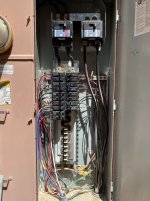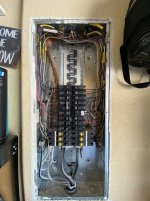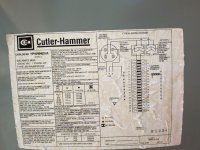hitehm
Senior Member
- Location
- Las Vegas NV
These split bus panels always get me. Please refer to the 2 pics. The "main panel" has a split bus with 2 breakers - 1 feeding the local enclosure's bus and the other feeding a second "remote panel", which btw is just on the other side of the wall but not sure the distance is relevant here. So I have 2 questions:
1- Is the 2nd panel a subpanel or just a second service equipment enclosure? It's got it's own service disconnect which is by code, grouped together in the main panel with the other. It's not being fed from a feeder however they ran an EGC with the conductors to the subpanel per feeder rules and as expected, did not bond it to the neutral bus in the 2nd panel.
So my second question is, was it necessary to run the EGC into the remote panel at all, or could they have just ran the N to the 2nd panel and bonded it to the EGC bar as a main bonding jumper? I believe 250.28 allows this. It seems to me it's a second service panel but with an EGC brought to it I'm not sure. And Is one way better than the other here?
If anyone is wondering why it matters, this is a solar design issue with load calc and 120% bus rules, etc. so knowing exactly what were dealing with is important.


1- Is the 2nd panel a subpanel or just a second service equipment enclosure? It's got it's own service disconnect which is by code, grouped together in the main panel with the other. It's not being fed from a feeder however they ran an EGC with the conductors to the subpanel per feeder rules and as expected, did not bond it to the neutral bus in the 2nd panel.
So my second question is, was it necessary to run the EGC into the remote panel at all, or could they have just ran the N to the 2nd panel and bonded it to the EGC bar as a main bonding jumper? I believe 250.28 allows this. It seems to me it's a second service panel but with an EGC brought to it I'm not sure. And Is one way better than the other here?
If anyone is wondering why it matters, this is a solar design issue with load calc and 120% bus rules, etc. so knowing exactly what were dealing with is important.




